tire size FORD ECOSPORT 2022 Warranty Guide
[x] Cancel search | Manufacturer: FORD, Model Year: 2022, Model line: ECOSPORT, Model: FORD ECOSPORT 2022Pages: 73, PDF Size: 3.06 MB
Page 7 of 73
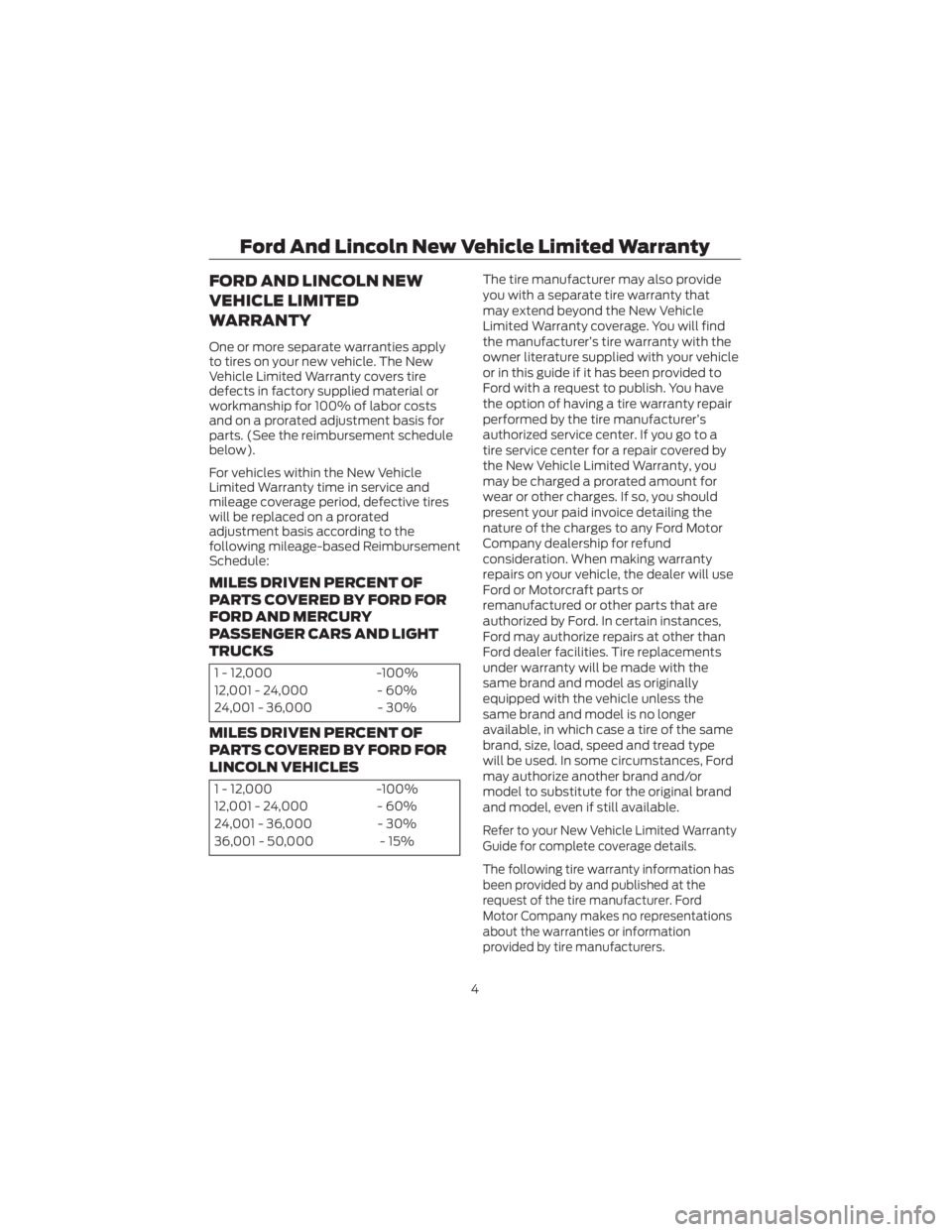
FORD AND LINCOLN NEW
VEHICLE LIMITED
WARRANTY
One or more separate warranties apply
to tires on your new vehicle. The New
Vehicle Limited Warranty covers tire
defects in factory supplied material or
workmanship for 100% of labor costs
and on a prorated adjustment basis for
parts. (See the reimbursement schedule
below).
For vehicles within the New Vehicle
Limited Warranty time in service and
mileage coverage period, defective tires
will be replaced on a prorated
adjustment basis according to the
following mileage-based Reimbursement
Schedule:
MILES DRIVEN PERCENT OF
PARTS COVERED BY FORD FOR
FORD AND MERCURY
PASSENGER CARS AND LIGHT
TRUCKS
1 - 12,000-100%
12,001 - 24,000 - 60%
24,001 - 36,000 - 30%
MILES DRIVEN PERCENT OF
PARTS COVERED BY FORD FOR
LINCOLN VEHICLES
1 - 12,000-100%
12,001 - 24,000 - 60%
24,001 - 36,000 - 30%
36,001 - 50,000 - 15%The tire manufacturer may also provide
you with a separate tire warranty that
may extend beyond the New Vehicle
Limited Warranty coverage. You will find
the manufacturer’s tire warranty with the
owner literature supplied with your vehicle
or in this guide if it has been provided to
Ford with a request to publish. You have
the option of having a tire warranty repair
performed by the tire manufacturer’s
authorized service center. If you go to a
tire service center for a repair covered by
the New Vehicle Limited Warranty, you
may be charged a prorated amount for
wear or other charges. If so, you should
present your paid invoice detailing the
nature of the charges to any Ford Motor
Company dealership for refund
consideration. When making warranty
repairs on your vehicle, the dealer will use
Ford or Motorcraft parts or
remanufactured or other parts that are
authorized by Ford. In certain instances,
Ford may authorize repairs at other than
Ford dealer facilities. Tire replacements
under warranty will be made with the
same brand and model as originally
equipped with the vehicle unless the
same brand and model is no longer
available, in which case a tire of the same
brand, size, load, speed and tread type
will be used. In some circumstances, Ford
may authorize another brand and/or
model to substitute for the original brand
and model, even if still available.
Refer to your New Vehicle Limited Warranty
Guide for complete coverage details.
The following tire warranty information has
been provided by and published at the
request of the tire manufacturer. Ford
Motor Company makes no representations
about the warranties or information
provided by tire manufacturers.
Ford And Lincoln New Vehicle Limited Warranty
4
Page 30 of 73
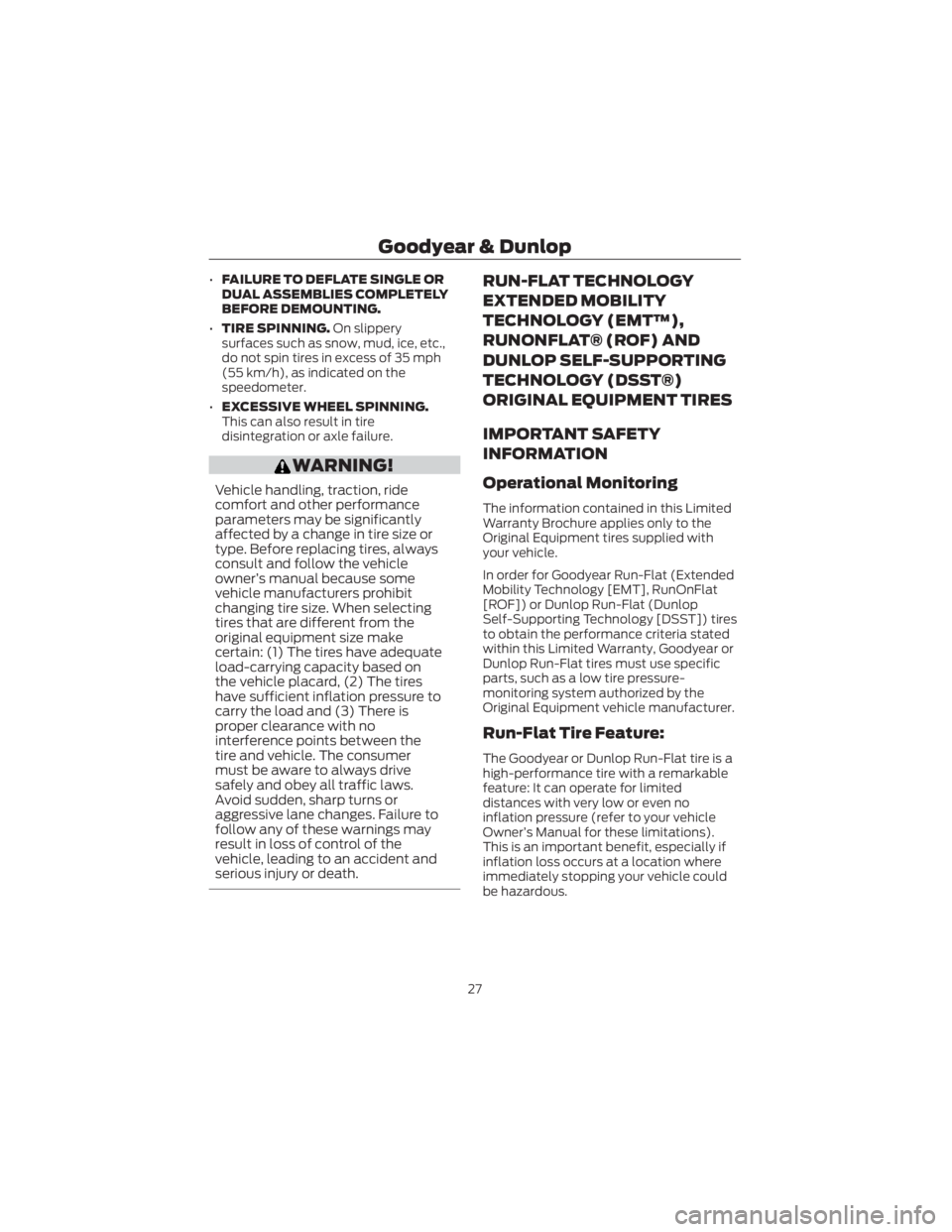
•FAILURE TO DEFLATE SINGLE OR
DUAL ASSEMBLIES COMPLETELY
BEFORE DEMOUNTING.
• TIRE SPINNING. On slippery
surfaces such as snow, mud, ice, etc.,
do not spin tires in excess of 35 mph
(55 km/h), as indicated on the
speedometer.
• EXCESSIVE WHEEL SPINNING.
This can also result in tire
disintegration or axle failure.
WARNING!
Vehicle handling, traction, ride
comfort and other performance
parameters may be significantly
affected by a change in tire size or
type. Before replacing tires, always
consult and follow the vehicle
owner’s manual because some
vehicle manufacturers prohibit
changing tire size. When selecting
tires that are different from the
original equipment size make
certain: (1) The tires have adequate
load-carrying capacity based on
the vehicle placard, (2) The tires
have sufficient inflation pressure to
carry the load and (3) There is
proper clearance with no
interference points between the
tire and vehicle. The consumer
must be aware to always drive
safely and obey all traffic laws.
Avoid sudden, sharp turns or
aggressive lane changes. Failure to
follow any of these warnings may
result in loss of control of the
vehicle, leading to an accident and
serious injury or death.
RUN-FLAT TECHNOLOGY
EXTENDED MOBILITY
TECHNOLOGY (EMT™),
RUNONFLAT® (ROF) AND
DUNLOP SELF-SUPPORTING
TECHNOLOGY (DSST®)
ORIGINAL EQUIPMENT TIRES
IMPORTANT SAFETY
INFORMATION
Operational Monitoring
The information contained in this Limited
Warranty Brochure applies only to the
Original Equipment tires supplied with
your vehicle.
In order for Goodyear Run-Flat (Extended
Mobility Technology [EMT], RunOnFlat
[ROF]) or Dunlop Run-Flat (Dunlop
Self-Supporting Technology [DSST]) tires
to obtain the performance criteria stated
within this Limited Warranty, Goodyear or
Dunlop Run-Flat tires must use specific
parts, such as a low tire pressure-
monitoring system authorized by the
Original Equipment vehicle manufacturer.
Run-Flat Tire Feature:
The Goodyear or Dunlop Run-Flat tire is a
high-performance tire with a remarkable
feature: It can operate for limited
distances with very low or even no
inflation pressure (refer to your vehicle
Owner’s Manual for these limitations).
This is an important benefit, especially if
inflation loss occurs at a location where
immediately stopping your vehicle could
be hazardous.
Goodyear & Dunlop
27
Page 39 of 73
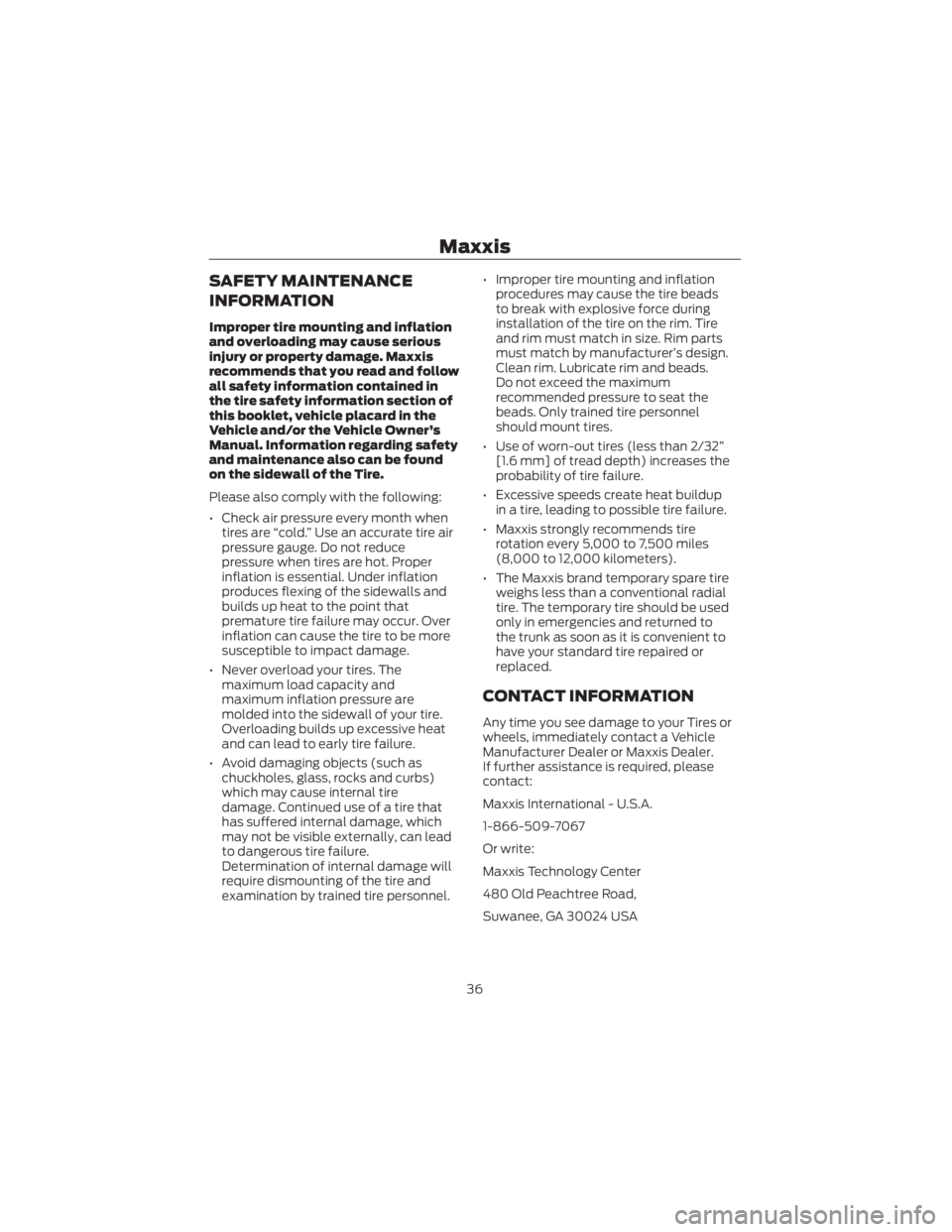
SAFETY MAINTENANCE
INFORMATION
Improper tire mounting and inflation
and overloading may cause serious
injury or property damage. Maxxis
recommends that you read and follow
all safety information contained in
the tire safety inf ormation section of
this booklet, vehicle placard in the
Vehicle and/or the Vehicle Owner’s
Manual. Information regarding safety
and maintenance also can be found
on the sidewall of the Tire.
Please also comply with the following:
• Check air pressure every month when tires are “cold.” Use an accurate tire air
pressure gauge. Do not reduce
pressure when tires are hot. Proper
inflation is essential. Under inflation
produces flexing of the sidewalls and
builds up heat to the point that
premature tire failure may occur. Over
inflation can cause the tire to be more
susceptible to impact damage.
• Never overload your tires. The maximum load capacity and
maximum inflation pressure are
molded into the sidewall of your tire.
Overloading builds up excessive heat
and can lead to early tire failure.
• Avoid damaging objects (such as chuckholes, glass, rocks and curbs)
which may cause internal tire
damage. Continued use of a tire that
has suffered internal damage, which
may not be visible externally, can lead
to dangerous tire failure.
Determination of internal damage will
require dismounting of the tire and
examination by trained tire personnel. • Improper tire mounting and inflation
procedures may cause the tire beads
to break with explosive force during
installation of the tire on the rim. Tire
and rim must match in size. Rim parts
must match by manufacturer’s design.
Clean rim. Lubricate rim and beads.
Do not exceed the maximum
recommended pressure to seat the
beads. Only trained tire personnel
should mount tires.
• Use of worn-out tires (less than 2/32” [1.6 mm] of tread depth) increases the
probability of tire failure.
• Excessive speeds create heat buildup in a tire, leading to possible tire failure.
• Maxxis strongly recommends tire rotation every 5,000 to 7,500 miles
(8,000 to 12,000 kilometers).
• The Maxxis brand temporary spare tire weighs less than a conventional radial
tire. The temporary tire should be used
only in emergencies and returned to
the trunk as soon as it is convenient to
have your standard tire repaired or
replaced.
CONTACT INFORMATION
Any time you see damage to your Tires or
wheels, immediately contact a Vehicle
Manufacturer Dealer or Maxxis Dealer.
If further assistance is required, please
contact:
Maxxis International - U.S.A.
1-866-509-7067
Or write:
Maxxis Technology Center
480 Old Peachtree Road,
Suwanee, GA 30024 USA
Maxxis
36
Page 45 of 73
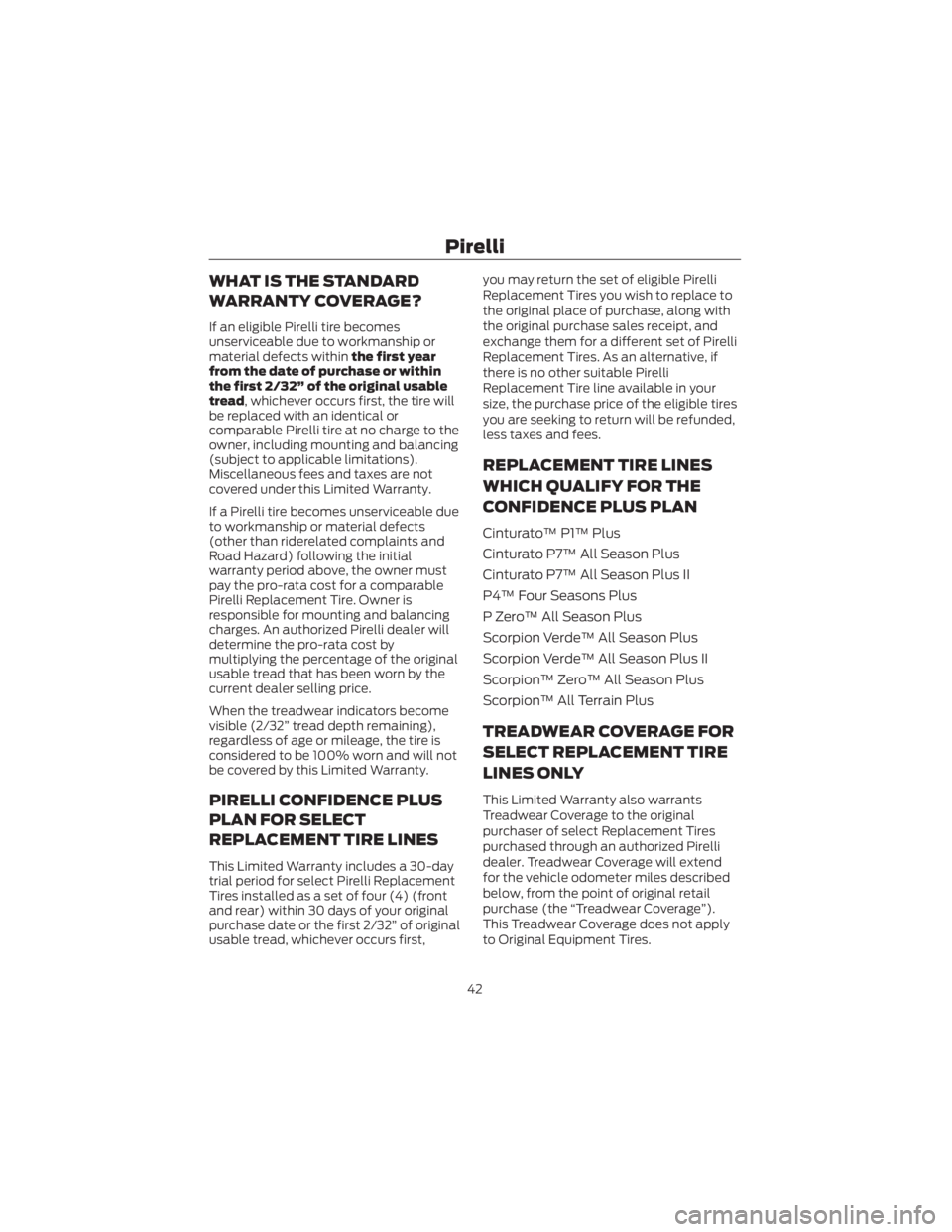
WHAT IS THE STANDARD
WARRANTY COVERAGE?
If an eligible Pirelli tire becomes
unserviceable due to workmanship or
material defects withinthe first year
from the date of purchase or within
the first 2/32” of the original usable
tread, whichever occurs first, the tire will
be replaced with an identical or
comparable Pirelli tire at no charge to the
owner, including mounting and balancing
(subject to applicable limitations).
Miscellaneous fees and taxes are not
covered under this Limited Warranty.
If a Pirelli tire becomes unserviceable due
to workmanship or material defects
(other than riderelated complaints and
Road Hazard) following the initial
warranty period above, the owner must
pay the pro-rata cost for a comparable
Pirelli Replacement Tire. Owner is
responsible for mounting and balancing
charges. An authorized Pirelli dealer will
determine the pro-rata cost by
multiplying the percentage of the original
usable tread that has been worn by the
current dealer selling price.
When the treadwear indicators become
visible (2/32” tread depth remaining),
regardless of age or mileage, the tire is
considered to be 100% worn and will not
be covered by this Limited Warranty.
PIRELLI CONFIDENCE PLUS
PLAN FOR SELECT
REPLACEMENT TIRE LINES
This Limited Warranty includes a 30-day
trial period for select Pirelli Replacement
Tires installed as a set of four (4) (front
and rear) within 30 days of your original
purchase date or the first 2/32” of original
usable tread, whichever occurs first, you may return the set of eligible Pirelli
Replacement Tires you wish to replace to
the original place of purchase, along with
the original purchase sales receipt, and
exchange them for a different set of Pirelli
Replacement Tires. As an alternative, if
there is no other suitable Pirelli
Replacement Tire line available in your
size, the purchase price of the eligible tires
you are seeking to return will be refunded,
less taxes and fees.
REPLACEMENT TIRE LINES
WHICH QUALIFY FOR THE
CONFIDENCE PLUS PLAN
Cinturato™ P1™ Plus
Cinturato P7™ All Season Plus
Cinturato P7™ All Season Plus II
P4™ Four Seasons Plus
P Zero™ All Season Plus
Scorpion Verde™ All Season Plus
Scorpion Verde™ All Season Plus II
Scorpion™ Zero™ All Season Plus
Scorpion™ All Terrain Plus
TREADWEAR COVERAGE FOR
SELECT REPLACEMENT TIRE
LINES ONLY
This Limited Warranty also warrants
Treadwear Coverage to the original
purchaser of select Replacement Tires
purchased through an authorized Pirelli
dealer. Treadwear Coverage will extend
for the vehicle odometer miles described
below, from the point of original retail
purchase (the “Treadwear Coverage”).
This Treadwear Coverage does not apply
to Original Equipment Tires.
Pirelli
42
Page 46 of 73
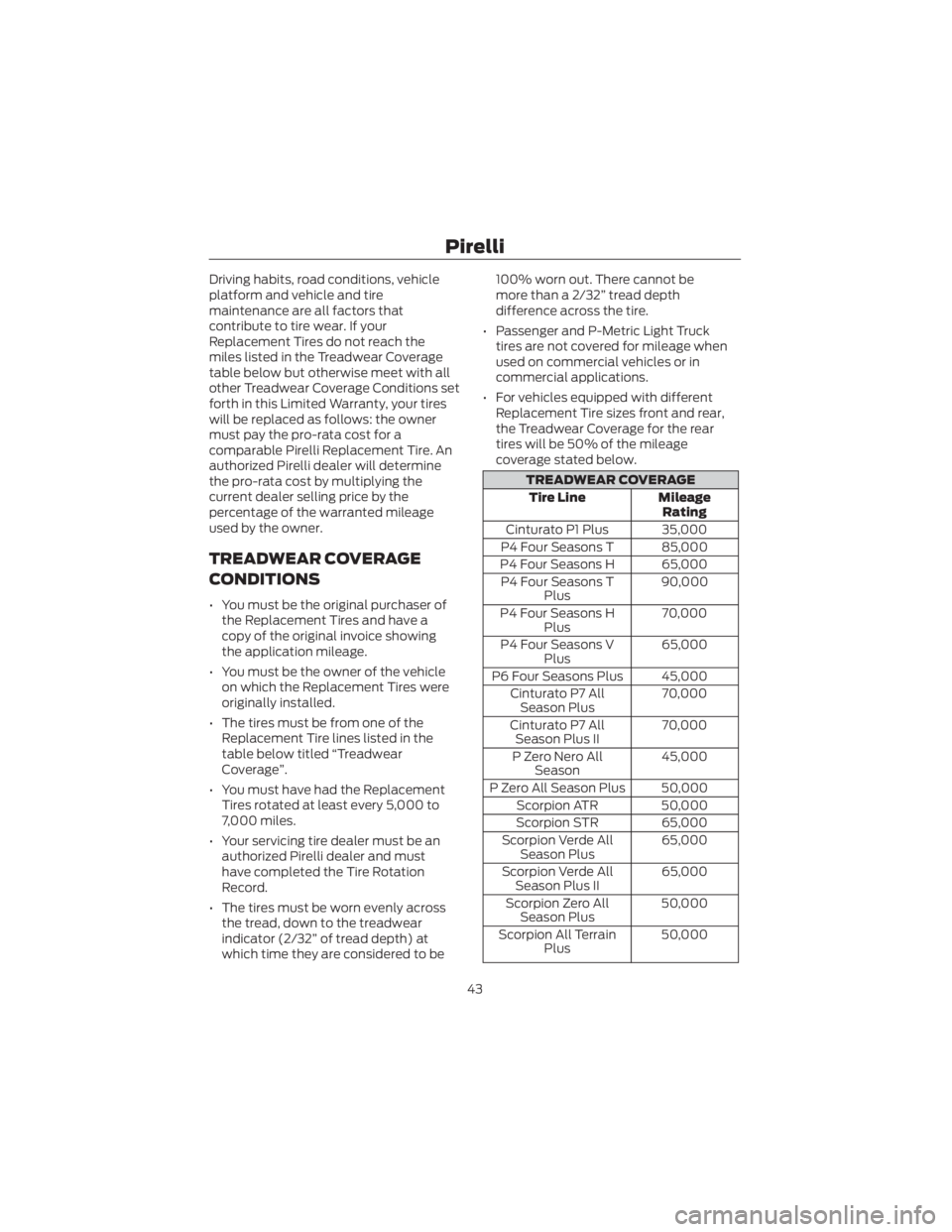
Driving habits, road conditions, vehicle
platform and vehicle and tire
maintenance are all factors that
contribute to tire wear. If your
Replacement Tires do not reach the
miles listed in the Treadwear Coverage
table below but otherwise meet with all
other Treadwear Coverage Conditions set
forth in this Limited Warranty, your tires
will be replaced as follows: the owner
must pay the pro-rata cost for a
comparable Pirelli Replacement Tire. An
authorized Pirelli dealer will determine
the pro-rata cost by multiplying the
current dealer selling price by the
percentage of the warranted mileage
used by the owner.
TREADWEAR COVERAGE
CONDITIONS
• You must be the original purchaser ofthe Replacement Tires and have a
copy of the original invoice showing
the application mileage.
• You must be the owner of the vehicle on which the Replacement Tires were
originally installed.
• The tires must be from one of the Replacement Tire lines listed in the
table below titled “Treadwear
Coverage”.
• You must have had the Replacement Tires rotated at least every 5,000 to
7,000 miles.
• Your servicing tire dealer must be an authorized Pirelli dealer and must
have completed the Tire Rotation
Record.
• The tires must be worn evenly across the tread, down to the treadwear
indicator (2/32” of tread depth) at
which time they are considered to be 100% worn out. There cannot be
more than a 2/32” tread depth
difference across the tire.
• Passenger and P-Metric Light Truck tires are not covered for mileage when
used on commercial vehicles or in
commercial applications.
• For vehicles equipped with different Replacement Tire sizes front and rear,
the Treadwear Coverage for the rear
tires will be 50% of the mileage
coverage stated below.
TREADWEAR COVERAGE
Tire Line Mileage
Rating
Cinturato P1 Plus 35,000
P4 Four Seasons T 85,000
P4 Four Seasons H 65,000 P4 Four Seasons T Plus 90,000
P4 Four Seasons H Plus 70,000
P4 Four Seasons V Plus 65,000
P6 Four Seasons Plus 45,000 Cinturato P7 AllSeason Plus 70,000
Cinturato P7 All Season Plus II 70,000
P Zero Nero All Season 45,000
P Zero All Season Plus 50,000 Scorpion ATR 50,000
Scorpion STR 65,000
Scorpion Verde All Season Plus 65,000
Scorpion Verde All Season Plus II 65,000
Scorpion Zero All Season Plus 50,000
Scorpion All Terrain Plus 50,000
Pirelli
43
Page 47 of 73
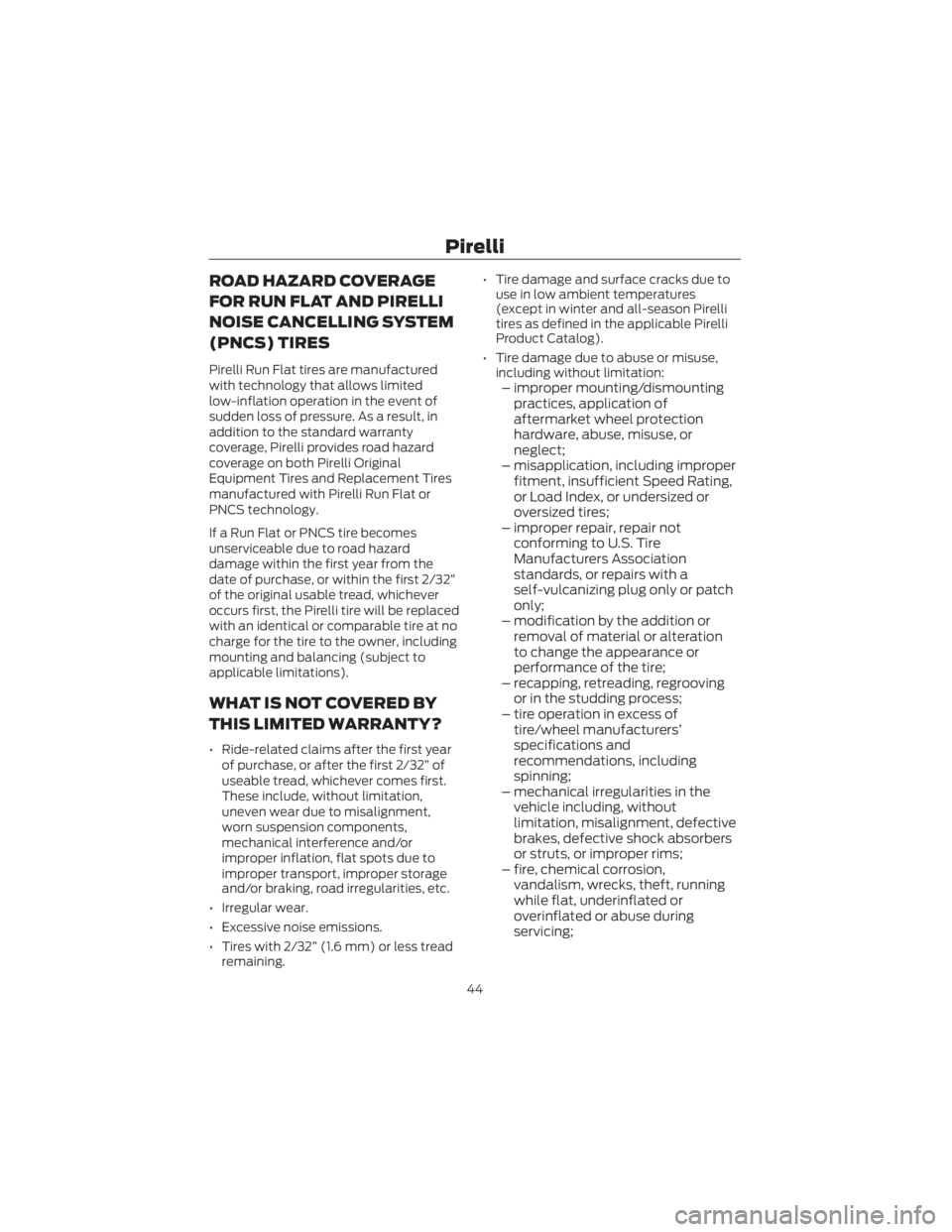
ROAD HAZARD COVERAGE
FOR RUN FLAT AND PIRELLI
NOISE CANCELLING SYSTEM
(PNCS) TIRES
Pirelli Run Flat tires are manufactured
with technology that allows limited
low-inflation operation in the event of
sudden loss of pressure. As a result, in
addition to the standard warranty
coverage, Pirelli provides road hazard
coverage on both Pirelli Original
Equipment Tires and Replacement Tires
manufactured with Pirelli Run Flat or
PNCS technology.
If a Run Flat or PNCS tire becomes
unserviceable due to road hazard
damage within the first year from the
date of purchase, or within the first 2/32”
of the original usable tread, whichever
occurs first, the Pirelli tire will be replaced
with an identical or comparable tire at no
charge for the tire to the owner, including
mounting and balancing (subject to
applicable limitations).
WHAT IS NOT COVERED BY
THIS LIMITED WARRANTY?
• Ride-related claims after the first yearof purchase, or after the first 2/32” of
useable tread, whichever comes first.
These include, without limitation,
uneven wear due to misalignment,
worn suspension components,
mechanical interference and/or
improper inflation, flat spots due to
improper transport, improper storage
and/or braking, road irregularities, etc.
• Irregular wear.
• Excessive noise emissions.
• Tires with 2/32” (1.6 mm) or less tread remaining. • Tire damage and surface cracks due to
use in low ambient temperatures
(except in winter and all-season Pirelli
tires as defined in the applicable Pirelli
Product Catalog).
• Tire damage due to abuse or misuse, including without limitation:
– improper mounting/dismountingpractices, application of
aftermarket wheel protection
hardware, abuse, misuse, or
neglect;
– misapplication, including improper fitment, insufficient Speed Rating,
or Load Index, or undersized or
oversized tires;
– improper repair, repair not conforming to U.S. Tire
Manufacturers Association
standards, or repairs with a
self-vulcanizing plug only or patch
only;
– modification by the addition or removal of material or alteration
to change the appearance or
performance of the tire;
– recapping, retreading, regrooving or in the studding process;
– tire operation in excess of tire/wheel manufacturers’
specifications and
recommendations, including
spinning;
– mechanical irregularities in the vehicle including, without
limitation, misalignment, defective
brakes, defective shock absorbers
or struts, or improper rims;
– fire, chemical corrosion, vandalism, wrecks, theft, running
while flat, underinflated or
overinflated or abuse during
servicing;
Pirelli
44
Page 51 of 73
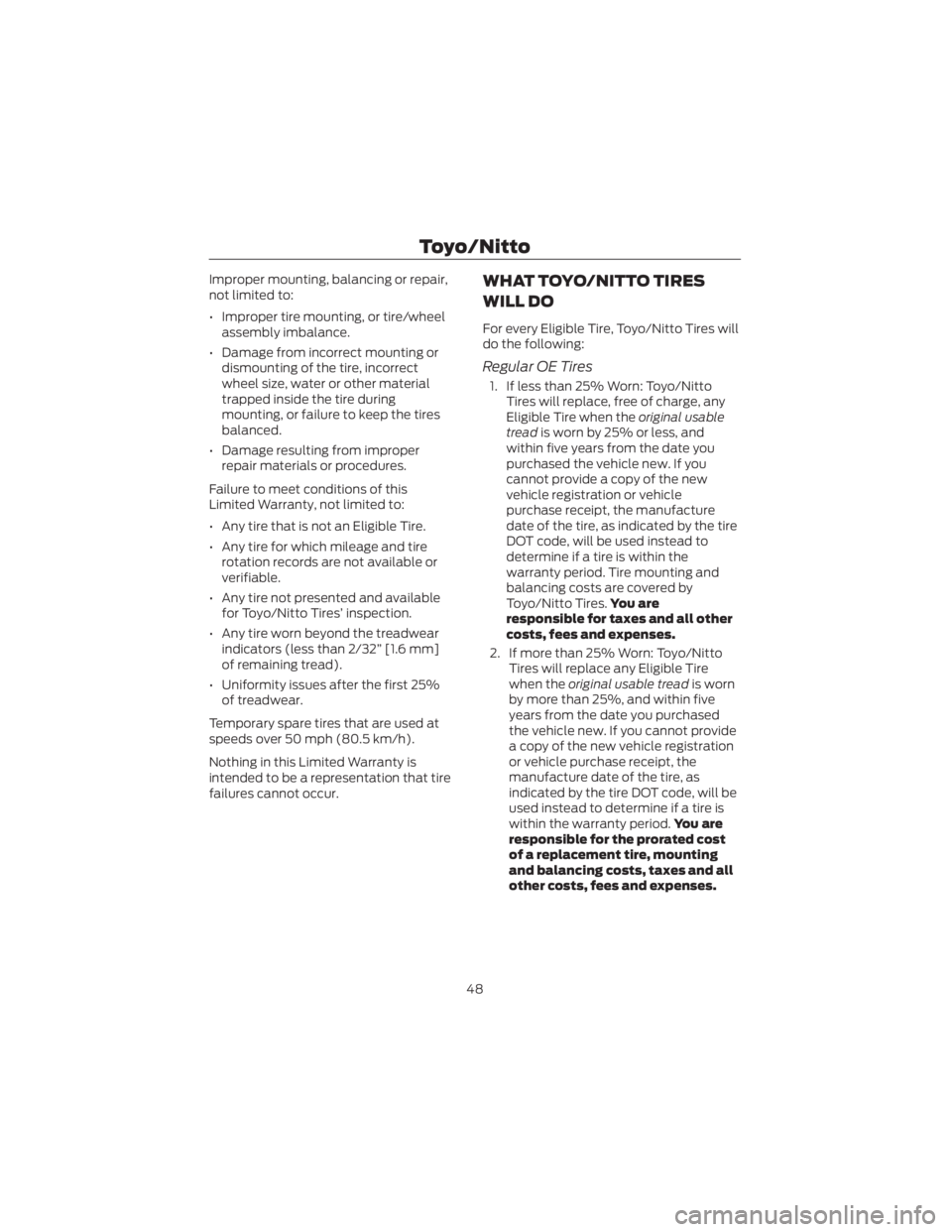
Improper mounting, balancing or repair,
not limited to:
• Improper tire mounting, or tire/wheelassembly imbalance.
• Damage from incorrect mounting or dismounting of the tire, incorrect
wheel size, water or other material
trapped inside the tire during
mounting, or failure to keep the tires
balanced.
• Damage resulting from improper repair materials or procedures.
Failure to meet conditions of this
Limited Warranty, not limited to:
• Any tire that is not an Eligible Tire.
• Any tire for which mileage and tire rotation records are not available or
verifiable.
• Any tire not presented and available for Toyo/Nitto Tires’ inspection.
• Any tire worn beyond the treadwear indicators (less than 2/32” [1.6 mm]
of remaining tread).
• Uniformity issues after the first 25% of treadwear.
Temporary spare tires that are used at
speeds over 50 mph (80.5 km/h).
Nothing in this Limited Warranty is
intended to be a representation that tire
failures cannot occur.WHAT TOYO/NITTO TIRES
WILL DO
For every Eligible Tire, Toyo/Nitto Tires will
do the following:
Regular OE Tires
1. If less than 25% Worn: Toyo/Nitto Tires will replace, free of charge, any
Eligible Tire when the original usable
tread is worn by 25% or less, and
within five years from the date you
purchased the vehicle new. If you
cannot provide a copy of the new
vehicle registration or vehicle
purchase receipt, the manufacture
date of the tire, as indicated by the tire
DOT code, will be used instead to
determine if a tire is within the
warranty period. Tire mounting and
balancing costs are covered by
Toyo/Nitto Tires. Yo u a r e
responsible for taxes and all other
costs, fees and expenses.
2. If more than 25% Worn: Toyo/Nitto Tires will replace any Eligible Tire
when the original usable tread is worn
by more than 25%, and within five
years from the date you purchased
the vehicle new. If you cannot provide
a copy of the new vehicle registration
or vehicle purchase receipt, the
manufacture date of the tire, as
indicated by the tire DOT code, will be
used instead to determine if a tire is
within the warranty period. Yo u a r e
responsible for the prorated cost
of a replacement tire, mounting
and balancing costs, taxes and all
other costs, fees and expenses.
Toyo/Nitto
48
Page 65 of 73
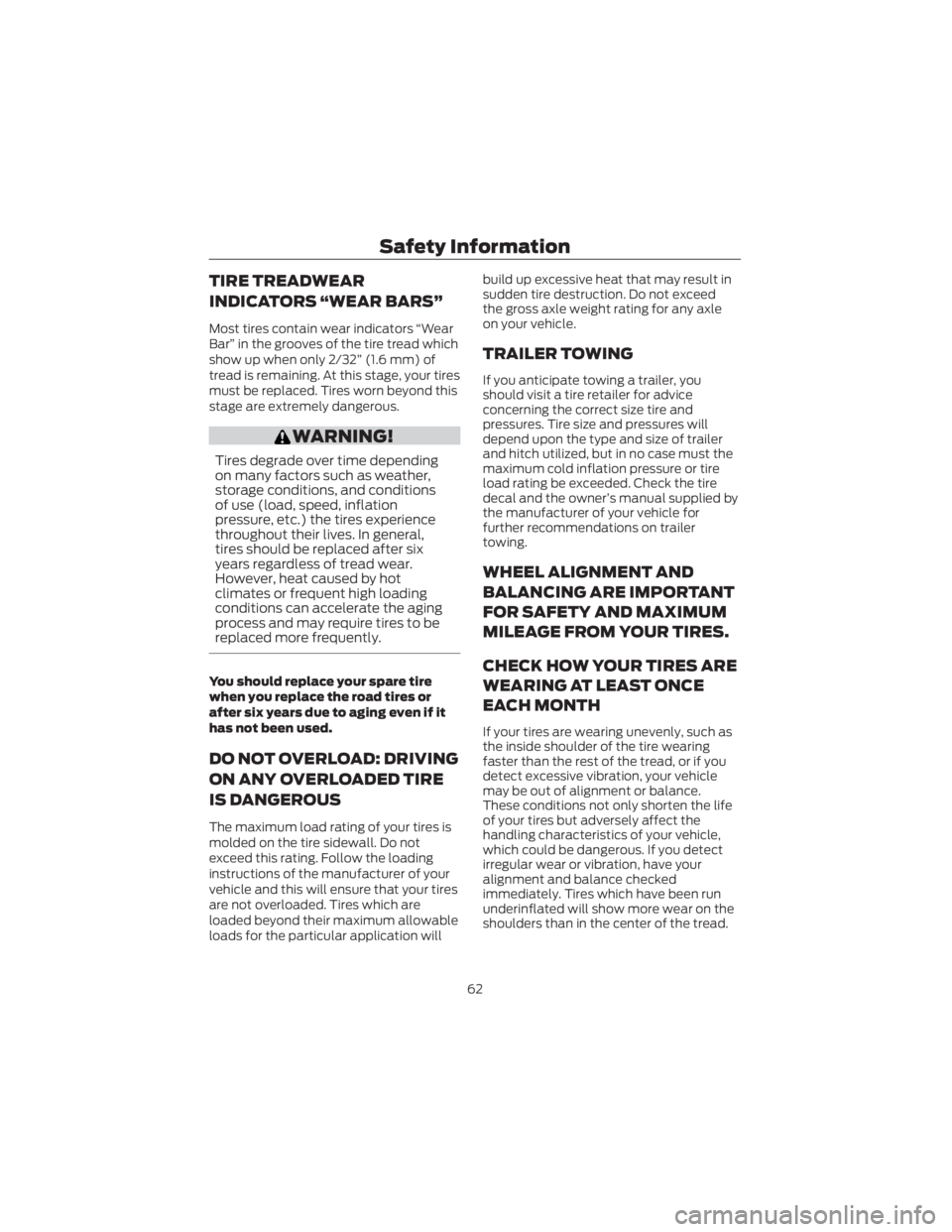
TIRE TREADWEAR
INDICATORS “WEAR BARS”
Most tires contain wear indicators “Wear
Bar” in the grooves of the tire tread which
show up when only 2/32” (1.6 mm) of
tread is remaining. At this stage, your tires
must be replaced. Tires worn beyond this
stage are extremely dangerous.
WARNING!
Tires degrade over time depending
on many factors such as weather,
storage conditions, and conditions
of use (load, speed, inflation
pressure, etc.) the tires experience
throughout their lives. In general,
tires should be replaced after six
years regardless of tread wear.
However, heat caused by hot
climates or frequent high loading
conditions can accelerate the aging
process and may require tires to be
replaced more frequently.
You should replace your spare tire
when you replace the road tires or
after six years due to aging even if it
has not been used.
DO NOT OVERLOAD: DRIVING
ON ANY OVERLOADED TIRE
IS DANGEROUS
The maximum load rating of your tires is
molded on the tire sidewall. Do not
exceed this rating. Follow the loading
instructions of the manufacturer of your
vehicle and this will ensure that your tires
are not overloaded. Tires which are
loaded beyond their maximum allowable
loads for the particular application willbuild up excessive heat that may result in
sudden tire destruction. Do not exceed
the gross axle weight rating for any axle
on your vehicle.
TRAILER TOWING
If you anticipate towing a trailer, you
should visit a tire retailer for advice
concerning the correct size tire and
pressures. Tire size and pressures will
depend upon the type and size of trailer
and hitch utilized, but in no case must the
maximum cold inflation pressure or tire
load rating be exceeded. Check the tire
decal and the owner’s manual supplied by
the manufacturer of your vehicle for
further recommendations on trailer
towing.
WHEEL ALIGNMENT AND
BALANCING ARE IMPORTANT
FOR SAFETY AND MAXIMUM
MILEAGE FROM YOUR TIRES.
CHECK HOW YOUR TIRES ARE
WEARING AT LEAST ONCE
EACH MONTH
If your tires are wearing unevenly, such as
the inside shoulder of the tire wearing
faster than the rest of the tread, or if you
detect excessive vibration, your vehicle
may be out of alignment or balance.
These conditions not only shorten the life
of your tires but adversely affect the
handling characteristics of your vehicle,
which could be dangerous. If you detect
irregular wear or vibration, have your
alignment and balance checked
immediately. Tires which have been run
underinflated will show more wear on the
shoulders than in the center of the tread.
Safety
Information
62
Page 66 of 73
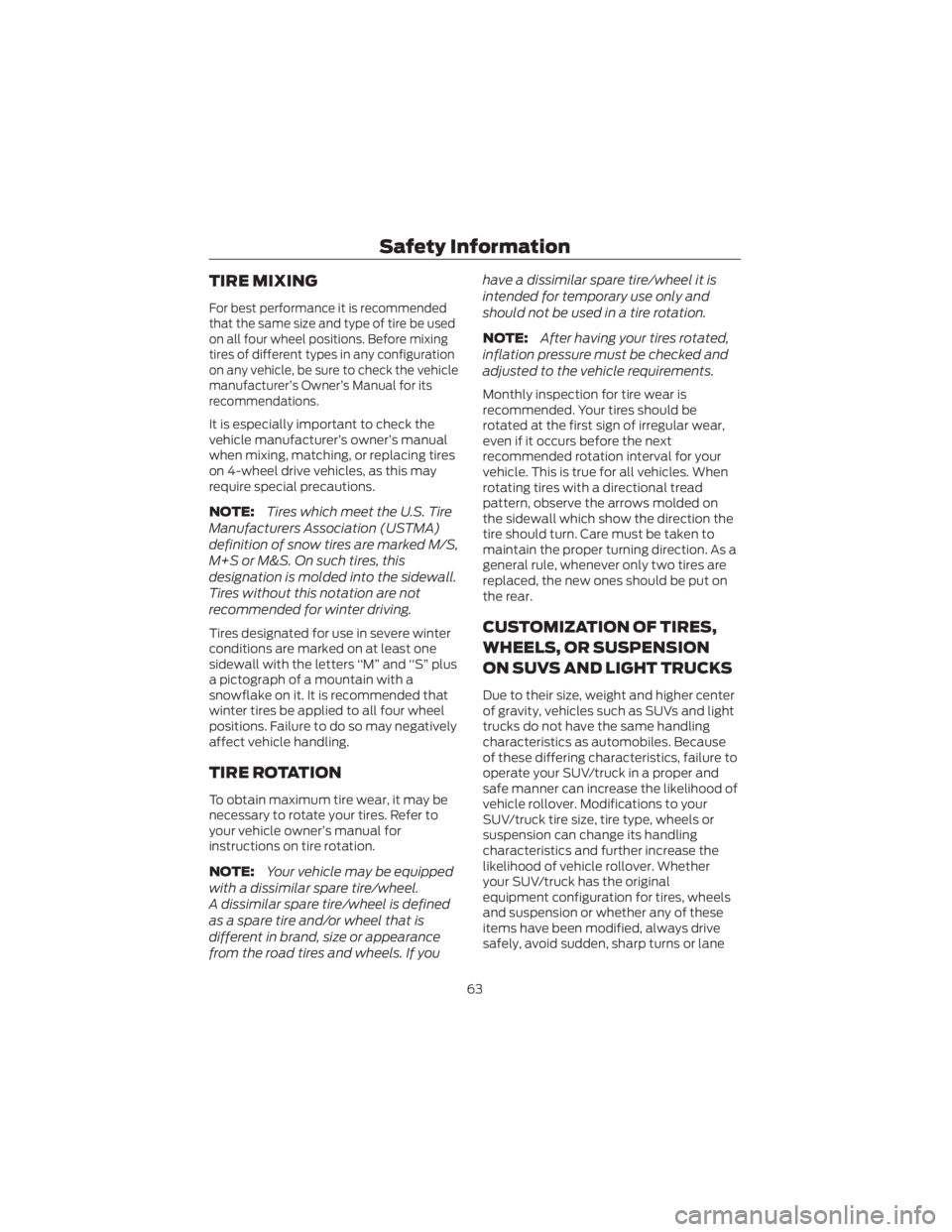
TIRE MIXING
For best performance it is recommended
that the same size and type of tire be used
on all four wheel positions. Before mixing
tires of different types in any configuration
on any vehicle, be sure to check the vehicle
manufacturer’s Owner’s Manual for its
recommendations.
It is especially important to check the
vehicle manufacturer’s owner’s manual
when mixing, matching, or replacing tires
on 4-wheel drive vehicles, as this may
require special precautions.
NOTE:Tires which meet the U.S. Tire
Manufacturers Association (USTMA)
definition of snow tires are marked M/S,
M+S or M&S. On such tires, this
designation is molded into the sidewall.
Tires without this notation are not
recommended for winter driving.
Tires designated for use in severe winter
conditions are marked on at least one
sidewall with the letters ‘‘M” and ‘‘S” plus
a pictograph of a mountain with a
snowflake on it. It is recommended that
winter tires be applied to all four wheel
positions. Failure to do so may negatively
affect vehicle handling.
TIRE ROTATION
To obtain maximum tire wear, it may be
necessary to rotate your tires. Refer to
your vehicle owner’s manual for
instructions on tire rotation.
NOTE: Your vehicle may be equipped
with a dissimilar spare tire/wheel.
A dissimilar spare tire/wheel is defined
as a spare tire and/or wheel that is
different in brand, size or appearance
from the road tires and wheels. If you have a dissimilar spare tire/wheel it is
intended for temporary use only and
should not be used in a tire rotation.
NOTE:
After having your tires rotated,
inflation pressure must be checked and
adjusted to the vehicle requirements.
Monthly inspection for tire wear is
recommended. Your tires should be
rotated at the first sign of irregular wear,
even if it occurs before the next
recommended rotation interval for your
vehicle. This is true for all vehicles. When
rotating tires with a directional tread
pattern, observe the arrows molded on
the sidewall which show the direction the
tire should turn. Care must be taken to
maintain the proper turning direction. As a
general rule, whenever only two tires are
replaced, the new ones should be put on
the rear.
CUSTOMIZATION OF TIRES,
WHEELS, OR SUSPENSION
ON SUVS AND LIGHT TRUCKS
Due to their size, weight and higher center
of gravity, vehicles such as SUVs and light
trucks do not have the same handling
characteristics as automobiles. Because
of these differing characteristics, failure to
operate your SUV/truck in a proper and
safe manner can increase the likelihood of
vehicle rollover. Modifications to your
SUV/truck tire size, tire type, wheels or
suspension can change its handling
characteristics and further increase the
likelihood of vehicle rollover. Whether
your SUV/truck has the original
equipment configuration for tires, wheels
and suspension or whether any of these
items have been modified, always drive
safely, avoid sudden, sharp turns or lane
Safety Information
63
Page 68 of 73
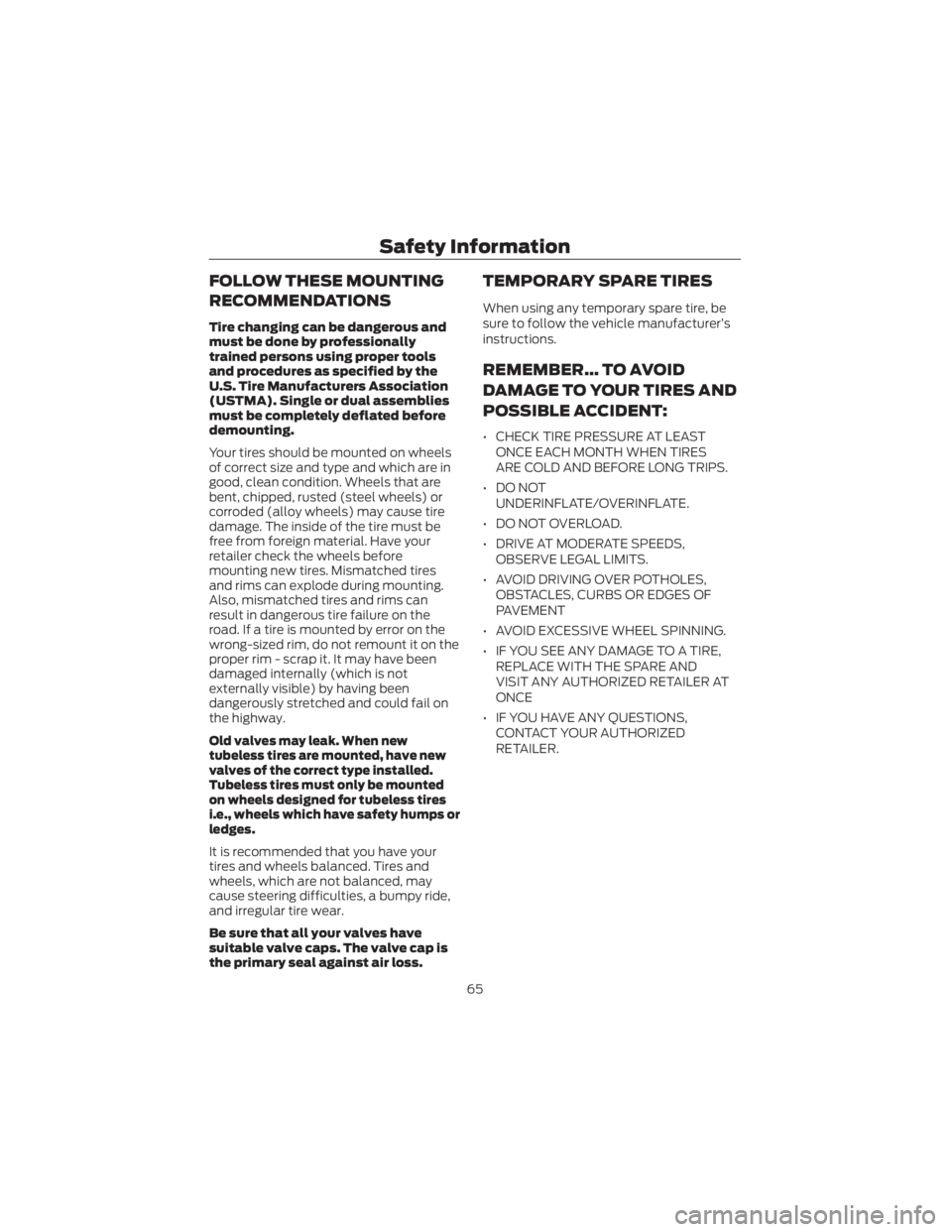
FOLLOW THESE MOUNTING
RECOMMENDATIONS
Tire changing can be dangerous and
must be done by professionally
trained persons using proper tools
and procedures as specified by the
U.S. Tire Manufacturers Association
(USTMA). Single or dual assemblies
must be completely deflated before
demounting.
Your tires should be mounted on wheels
of correct size and type and which are in
good, clean condition. Wheels that are
bent, chipped, rusted (steel wheels) or
corroded (alloy wheels) may cause tire
damage. The inside of the tire must be
free from foreign material. Have your
retailer check the wheels before
mounting new tires. Mismatched tires
and rims can explode during mounting.
Also, mismatched tires and rims can
result in dangerous tire failure on the
road. If a tire is mounted by error on the
wrong-sized rim, do not remount it on the
proper rim - scrap it. It may have been
damaged internally (which is not
externally visible) by having been
dangerously stretched and could fail on
the highway.
Old valves may leak. When new
tubeless tires are mounted, have new
valves of the correct type installed.
Tubeless tires must only be mounted
on wheels designed for tubeless tires
i.e., wheels whichhave safetyhumps or
ledges.
It is recommended that you have your
tires and wheels balanced. Tires and
wheels, which are not balanced, may
cause steering difficulties, a bumpy ride,
and irregular tire wear.
Be sure that all your valves have
suitable valve caps. The valve cap is
the primary seal against air loss.
TEMPORARY SPARE TIRES
When using any temporary spare tire, be
sure to follow the vehicle manufacturer’s
instructions.
REMEMBER... TO AVOID
DAMAGE TO YOUR TIRES AND
POSSIBLE ACCIDENT:
• CHECK TIRE PRESSURE AT LEAST
ONCE EACH MONTH WHEN TIRES
ARE COLD AND BEFORE LONG TRIPS.
•DONOT UNDERINFLATE/OVERINFLATE.
• DO NOT OVERLOAD.
• DRIVE AT MODERATE SPEEDS, OBSERVE LEGAL LIMITS.
• AVOID DRIVING OVER POTHOLES, OBSTACLES, CURBS OR EDGES OF
PAVEMENT
• AVOID EXCESSIVE WHEEL SPINNING.
• IF YOU SEE ANY DAMAGE TO A TIRE, REPLACE WITH THE SPARE AND
VISIT ANY AUTHORIZED RETAILER AT
ONCE
• IF YOU HAVE ANY QUESTIONS, CONTACT YOUR AUTHORIZED
RETAILER.
Safety Information
65